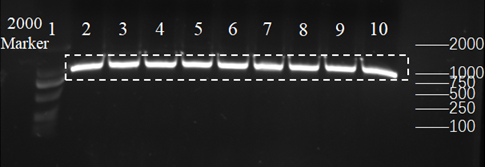Part:BBa_K3365015
pBAD upstream of eGFP with inhibition unit containing lure1
To facilitate measurements, we use the eGFP as a reporter protein, which can be exchange to other reporters according to the users’ needs. The eGFP gene sequence (BBa_K1875003) is located directly downstream of BBa_K3365007 (Lure1 sequence downstream of pBAD) followed by BBa_B0015 (rrnBT1-T7TE). The transcription of the eGFP gene is under the control of the inducible pBAD/araC promoter designed to carry PAM and lure1 sequence downstream of pBAD. In our part, the “lure1” is the potential off-target sequence for PDCD1 CRISPR gene editing mentioned in the literature, which might be identified and bound by the complex of dCas9 and sgRNA. According to the reference, the absolute off-target rate is 0.08286%.

Usage and Biology
This part is used to expression of eGFP protein regulated by the signal of arabinose and the off-target or not of dCas9. The pBAD is regulated by the AraC protein, which is both a positive and a negative regulator. The binding of dCas9 to any position within the region between the promotor and RBS might prevent transcription. Therefore, the uninduced transcriptional level of eGFP is very low. In the presence of arabinose, transcription from the pBAD promoter is turned on and there will be a relatively strong fluorescence expression. In the presence of both arabinose and the complex of dCas9 and sgRNA, the complex might bind to the lure1 sequence wrongly and the transcription is partially inhibited because of the block of RNAP. So, a relatively weak fluorescence expression of bacteria indicates a dCas9 with higher off-target rate that inhibits the expression of reporter gene.
Results
The promoter of the L-arabinose operon of E. coli (pBAD) is amplified to add restriction cutting sites, lure1 sequence and part of the RBS sequence (BBa_K3365002). The eGFP with double terminator is amplified to add restriction cutting sites and part of the RBS sequence (BBa_K3365002). The above PCR products are ligated through overlap PCR to get the fragment with suitable restriction sites and the product can be ligated into its backbone pUC57 by enzymic digestion and connection. The eletrophoretic profile of the overlap PCR product and the sequencing result reveal the successful construction of the fragment.

Sequence and Features
- 10COMPATIBLE WITH RFC[10]
- 12COMPATIBLE WITH RFC[12]
- 21INCOMPATIBLE WITH RFC[21]Illegal BamHI site found at 1053
Illegal XhoI site found at 1062 - 23COMPATIBLE WITH RFC[23]
- 25INCOMPATIBLE WITH RFC[25]Illegal AgeI site found at 74
- 1000INCOMPATIBLE WITH RFC[1000]Illegal SapI site found at 56
| None |
